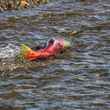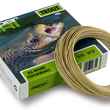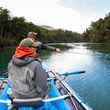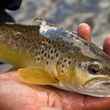I travel a lot, and I almost always travel with a significant amount of fly-fishing gear. From rods and reels and boxes of flies to waders, boots and rain gear, I can max out my 50-pound weight limit for a checked bag after just five minutes of packing.
But that’s never my goal when I prepare for a trip — particularly a long trip where fishing is virtually the sole purpose of the adventure. Rather, I aim to pack as efficiently as possible. And, to be honest, I’ve gotten pretty good at it.
I have found that the packing vessel — the temporary steward of all my gear — can be a huge help. Hard-bottomed, multi-compartment rolling duffels with room for rod tubes and other gear seem to serve my packing style best. That’s not to say they’re perfect, but I can almost always approach the luggage scale at the bag-drop counter knowing that I’m going to be really close to my weight limit, without going over. Eat your heart out, Drew Carey.
Sometimes, I’ve even a pound or two on the light side.
But, for frequent travelers, a hybrid-style rolling duffel (hard on the bottom, soft on top) has a limited lifespan. While we can be hard on luggage as we tote it around airports, load it into trucks, boats or even on the back of a good horse or mule, the real wear and tear comes from the behind-the-scenes airport baggage handlers.
These folks don’t give a damn about you or your luggage (or the thousands of dollars of fly-fishing gear you’ve carefully packed inside of it). Like you, though, they are all about efficiency. Unlike you, the contents are immaterial and there’s no “taking it easy” on luggage when there are 150 bags to load into the belly of a 737 or a dozen bags to stuff into the stowage compartment of an Otter.
The first thing you’ll notice, if you ever follow your bag from the scale to the conveyor belt, is that it’s placed upside down for the trip into the bowels of the airport (this, theoretically, just keeps the bag stationary). The next time you see your duffel, it’ll probably be upside down again as it’s spit out of the luggage chute and slides down to the base of the baggage claim carousel.
I don’t even want to think of the horrors it endures behind the black, rubber flaps it passes through as it disappears from view. But I do want to know that the bag I’ve chosen can stand up to the stresses placed upon it by cracking conveyor belts, careless handlers, weather, long walks through airports and parking lots and those tricky escalators that grab loose straps and snare bag corners.
Seriously. Luggage goes through hell. I’ve found that the average rolling duffel from reputable manufacturers has a dependable lifespan of maybe three years. Sometimes less. Rarely longer. So, the effort to find the ideal rolling duffel with some staying power continues.
My latest test subject? The Orvis Trekkage LT 80-liter rolling bag.
Initial thoughts
Honestly, at first blush, I was skeptical. But then I got my hands on it. The bag’s camo-patterned outer shell has the appearance of lightweight nylon, but once I felt the material, I was reassured. Looks can be deceiving, and the outer shell is actually a very durable layer of completely recycled 600-denier, tightly woven Cordura. High-wear areas around the corners are crafted with even heavier material — 800-denier Cordura. The bottom, or the back case, is a tough, hardshell material that seems to hold its shape well.
Second is its shape. It’s a bit longer than my now-retired rolling duffel — it measures a full 31 inches. It also sports a deeper main storage compartment. Overall, the bag is a full 10 and a half inches deep, which is great for packing rods, boots, waders and rain gear. At a full 15 inches wide, there’s space for five fly rods at the bottom and room atop the rod tubes for the rest of the gear.
The depth of the main compartment comes with a sacrifice, however. There’s no top access to the inside of the bag — instead of a full “compartment” for clothes that, in other brand-name models, is separated by a zippered divider and can be opened without exposing all the contents of the bag, all access to the Trekkage is earned by opening it up completely. Once it’s open, there are two separate compartments on the inside of the lid, accessed by zippered nylon separators, for soft goods, clothes, etc.
Finally, and maybe most importantly, are the wheels. Constructed with crush-resistant polycarbonate rims and lined with grippy rubber for the “tires,” the mobility of the bag looked very promising. And, I noticed, the wheels were assembled simply. This means they can likely be replaced or repaired quickly — a big plus that should work to extend the lifespan of the bag.
Honestly, things looked promising.
What works
Weight
Let’s start with the basics. The Trekkage weighs in at just under 10 pounds, which is quite light for a bag this size. In fact, it’s 23 percent lighter than Orvis’ previous iteration of a large rolling bag, the Safe Passage. This simply means there’s room for more gear.
Space
I love the depth of the main compartment. On a recent trip to Iceland, I was able to load it with five rod tubes, sturdy wading boots, carefully rolled chest waders, eight fly reels, half-a-dozen fly boxes, a fishing vest full of everything from tippet and leader to split shot and mitten clamps and two rain jackets.
Zipper
The 80L Trekkage’s zipper construction is durable and smooth, and, even with a full bag, the corners hold their shape well, making closing the bag much easier than in other models I’ve used over the years.
Wheels and Handle
Once packed, the sturdy wheels performed as good as they looked — pulling the bag through the Salt Lake City airport was a breeze, and when we had to walk a bit after grabbing our luggage in Keflavik, there were no issues. After loading and unloading the full bag into the rental car for a few days of touring, I half expected the hard shell casing around the bag’s wheel wells to sag or become misshapen — this is a problem with a lot of wheeled bags. But not so with the Trekkage. The back case is sturdy and stands up to being wheeled around while fully packed.
The collapsible trolley handle, maybe because the bag is just fraction taller than others I’ve used, maxes out at just the right length, and the handle is ergonomic and comfortable.
Respectable Water Resistance
Finally, and I didn’t really expect this given its Cordura construction, the Trekkage is admirably water resistant. It was exposed to some rain on an airport tarmac on the way home from Iceland, and the water beaded up and dripped off the Trekkage. Zero penetration. Nicely done, Orvis.
What doesn’t
Partitioning
I’m not a fan of the lack of an independently accessible compartment atop the bag. I get why Orvis made this call — adding depth to the protected bottom two-thirds of the bag is really nice. But it kind of limits the bag’s ability to be the only fishing travel luggage for most anglers. Yes, the two independent compartments in the lid offer some room for clothes and such, but dedicated space for attire is limited in this bag.
Rather than use the two compartments for non-fishing clothing, I opted to use them to pack three pairs of fleece pants for wear under my waders and both rain jackets. I suppose, had I been packing for a saltwater trip, I could have likely used those compartments for all the quick-dry clothing I wear on the flats, or even just underwear, t-shirts, socks, etc. But this was a cold-weather trip, so that wasn’t an option.
Additionally, the bag comes with a single exterior compartment accessed via zipper. It’s small and I’m not sure what purpose it serves. I get that exterior compartments are tricky — you don’t want to encourage travelers to stow too much on the margins (see the note about careless baggage handlers above), but functionality has to come into play at some point.
Maybe, in future iterations, a larger flat pocket on top could be used for a layer of clothing, like socks, face gaiters or even folded shirts. I wouldn’t store anything hard or sharp (car keys, nippers, hemos, etc.) or anything with corners in this pocket — it opens up the possibility of immediate wear, even with the durable Cordura outer shell.
Final Word
I really like the Trekkage 80L roller. The extra length means I don’t have to wedge rod tubes into the bottom of the bag, and there’s more than enough room for all the needed gear. The bag’s construction seems to hold up well and it rolls like a champ.
After several trips with the Trekkage LT 80L, I’ve come to appreciate its durability. Orvis was smart to reinforce the corners and the high-wear portions of the bag. Also, the water resistance of the luggage is a huge plus.
In all, Orvis’ new Trekkage LT Roller is an excellent investment for frequent travelers who expose their luggage to the elements. What’s more, the ease of repairing the moving parts of the bag — the wheel system is insanely simple, and even I, with my English-major brain, can figure it out — should extend the bag’s life. I’m looking forward to years of use from this bag.































Comments